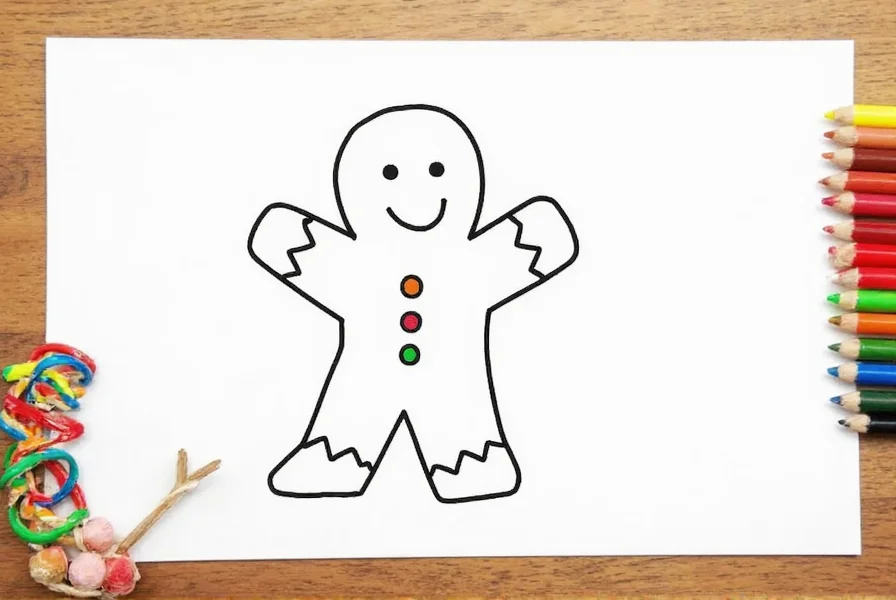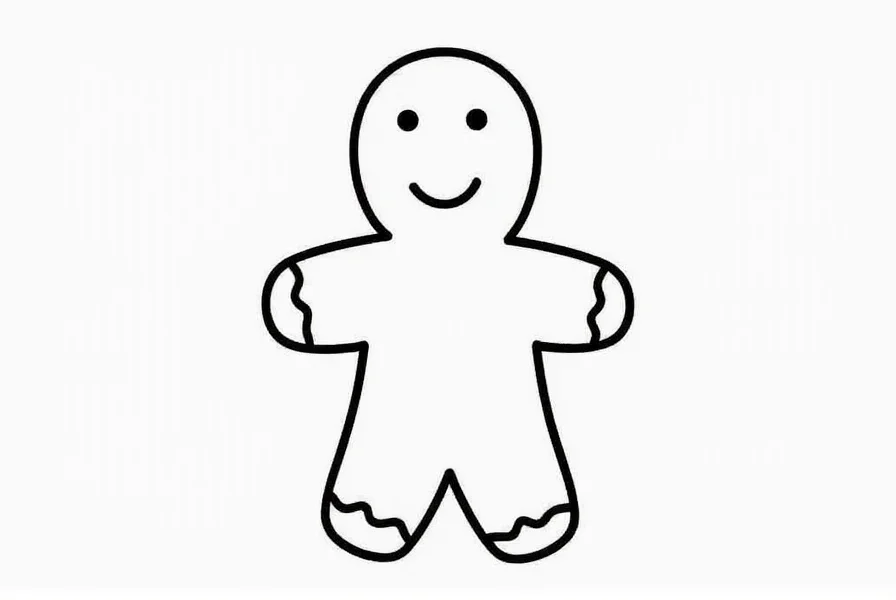Creating a gingerbread man drawing is an accessible art project perfect for holiday celebrations, classroom activities, or festive decorations. This timeless character has delighted children and adults for generations with its charming cookie appearance and joyful spirit. Whether you're a beginner artist, a teacher planning a classroom activity, or a parent looking for a fun holiday craft, this comprehensive guide provides everything you need to create your own gingerbread man illustration.
Essential Materials for Gingerbread Man Drawing
Before starting your gingerbread man drawing, gather these basic supplies:
| Material | Recommended Options | Best For |
|---|---|---|
| Paper | Plain printer paper, sketch paper, cardstock | All skill levels |
| Drawing Tools | Pencils, colored pencils, markers, crayons | Beginners to advanced artists |
| Optional Supplies | Eraser, ruler, colored paper, glitter | Enhanced creative projects |
Step-by-Step Gingerbread Man Drawing Guide
Follow these straightforward steps to create your gingerbread man drawing. This method works well for beginners and can be adapted for more advanced illustrations.
Step 1: Create the Basic Structure
Start with light pencil strokes to establish your gingerbread man's proportions:
- Draw a medium-sized circle for the head (about 2 inches in diameter)
- Beneath the circle, sketch a rectangle that's approximately twice as tall as the circle is wide
- Add two small rectangles extending from the bottom for legs
- Draw two slightly curved lines extending from the sides for arms
Step 2: Refine the Cookie Shape
Transform your basic shapes into a recognizable gingerbread cookie appearance:
- Round the corners of the rectangular body slightly
- Add a small semicircle at the top of the head for the classic cookie bump
- Connect the arms and legs smoothly to the body
- Define the characteristic gingerbread man outline with clean, flowing lines
Step 3: Add Signature Details
Now incorporate the distinctive features that make your drawing unmistakably a gingerbread man:
- Draw three evenly spaced buttons down the center of the body
- Create a simple smiling face with dot eyes and a curved mouth
- Add decorative icing details around the edges using wavy lines
- Include cookie cracks on the surface for realistic texture
Adapting Your Gingerbread Man Drawing for Different Skill Levels
For Young Children
When teaching kids how to draw a gingerbread man, simplify the process:
- Use larger, more basic shapes
- Focus on just the head, body, and three buttons
- Provide pre-drawn templates they can trace
- Encourage coloring rather than detailed drawing
For Beginners
If you're new to drawing, try these approachable techniques for your gingerbread man drawing:
- Use a pencil with a light touch for easy corrections
- Break the drawing into simple geometric shapes
- Practice the basic outline several times before adding details
- Focus on symmetry by drawing one side and mirroring it
For Advanced Artists
Experienced illustrators can enhance their gingerbread man drawing with:
- Shading to create a 3D cookie effect
- Detailed icing patterns and decorations
- Background elements like holiday scenes
- Watercolor or mixed media techniques

Creative Variations to Try
Once you've mastered the basic gingerbread man drawing, experiment with these creative adaptations:
- Holiday-themed versions: Add Santa hats, reindeer antlers, or Easter baskets
- Character variations: Create gingerbread families with different sizes and features
- Seasonal adaptations: Summer gingerbread men with sunglasses or winter versions with scarves
- Story illustrations: Draw your gingerbread man in action, running from the oven
Common Mistakes to Avoid
When creating your gingerbread man drawing, watch out for these frequent errors:
- Proportion issues - heads too small or bodies too narrow
- Overcomplicating the design for beginner skill levels
- Forgetting the characteristic cookie texture details
- Mismatched or asymmetrical features
- Using too many colors that overwhelm the simple design
Practical Applications for Your Gingerbread Man Drawing
Your finished gingerbread man drawing can serve multiple purposes:
- Create personalized holiday cards for friends and family
- Design classroom decorations for December activities
- Develop patterns for cookie cutters or embroidery projects
- Illustrate children's stories or holiday books
- Make templates for gingerbread house decorations
Troubleshooting Your Gingerbread Man Drawing
If you're struggling with specific aspects of your drawing, try these solutions:
- Uneven features: Fold your paper in half to check symmetry
- Proportion problems: Use a grid system to maintain correct ratios
- Stiff appearance: Add slight curves to straight lines for more natural flow
- Lack of detail: Study real gingerbread cookies for authentic texture references
- Color issues: Stick to a limited palette of brown, red, green, and white for traditional appeal
Frequently Asked Questions
What's the easiest way for beginners to draw a gingerbread man?
The simplest approach is to start with basic geometric shapes: draw a circle for the head, a rectangle for the body, and smaller rectangles for arms and legs. Connect these shapes with smooth lines, then add three buttons down the center and a simple smiling face. Using light pencil strokes initially allows for easy corrections as you refine your gingerbread man drawing.
How can I make my gingerbread man drawing look more realistic?
To create a more realistic gingerbread man drawing, focus on texture details. Add subtle cracks across the surface to mimic baked cookie texture, include slight variations in the brown coloring, and create dimension with light shading. Pay attention to how light would hit a 3D cookie - add darker shading on one side and highlights on the opposite. The icing details should look slightly raised from the surface for authentic appearance.
What are good materials for creating gingerbread man drawings with children?
For children's gingerbread man drawing projects, use thick paper or cardstock that won't tear easily. Crayons, washable markers, or chunky colored pencils work best for small hands. Consider providing pre-drawn templates they can trace, then decorate. Adding glitter glue for icing details or using brown paper bags cut into cookie shapes creates engaging multi-sensory experiences that enhance the simple gingerbread man drawing process.
How can I adapt a gingerbread man drawing for different holidays?
Transform your basic gingerbread man drawing for various holidays by adding thematic elements. For Christmas, include a Santa hat and holiday colors. For Valentine's Day, add heart decorations and pink accents. Easter versions can feature bunny ears and spring colors, while Halloween adaptations might include a witch's hat and orange details. The key is maintaining the core gingerbread man structure while incorporating seasonal accessories that match the holiday theme.
What are common mistakes to avoid when drawing a gingerbread man?
Common errors in gingerbread man drawings include disproportionate features (like a head too small for the body), overly complex designs for beginners, missing the characteristic cookie texture, and asymmetrical elements. Many beginners also forget the traditional three buttons down the center or make the arms and legs too thin. To avoid these issues, start with light construction lines, check proportions frequently, and study reference images of actual gingerbread cookies for authentic details.











 浙公网安备
33010002000092号
浙公网安备
33010002000092号 浙B2-20120091-4
浙B2-20120091-4